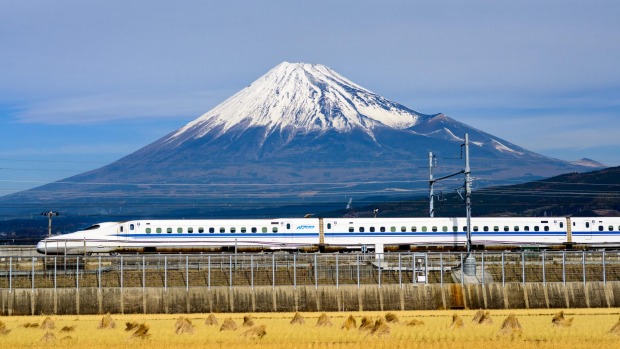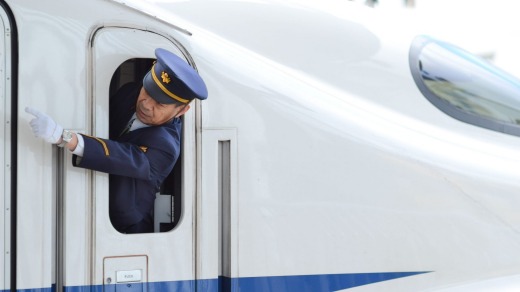
SPONSORED ARTICLE
Cameras and smartphones in focus, we're all hunched over the windows on the left side of the bullet train from Himeji to Tokyo. It's a cloudy day, and the train is going 270 kilometres per hour but maybe, just maybe we can get a shot in of Mount Fuji. The glimpse is fleeting, with the peak just visible through the gloom but no one seems to mind, as I retreat back to my spacious seat and point my chopsticks into the last compartment of the ekiben bento box.
Even 52 years after the introduction of bullet trains or shinkansen (meaning "new trunk line"), the journey still feels futuristic. This is by no means train travel of a bygone era, but arguably it's just as romantic. When bullet trains first catapulted out of the stations in Tokyo and Osaka nine days before the opening ceremony of the 1964 Tokyo Olympic Games, the world took notice. Like a lot of mid-century design at the time they were sleek, modern and optimistic; it was the space age after all.

Newspapers dubbed shinkansen the "Super-Express of Dreams"; these curved white beacons of progress were a symbol that Japan had the technology and skill to be a superpower. Trains were given names to reflect this post-war confidence, such as Hikari ("Ray of Light"). Japan Rail asked the public for name ideas. A popular entry that was rejected was Atom, after Mighty Atom, the cartoon character known as Astro Boy in Australia.
Today, on my 8.58am service to Tokyo, we can expect to arrive before noon. If we were driving this journey would take nine hours. Over the years the shinkansen have sped up. The original bullet trains could take travellers from Tokyo to Osaka in four hours, now it takes just two hours and 25 minutes. Proof that Japan is still a major game-player in technology, new hovering trains, using magnetic levitation or maglev, which can reach speeds of 500 kilometres per hour, are to be completed from Tokyo-Osaka by 2027.
New routes are opening up as well. Last March (2015), the new Hokuriku line began taking passengers into Honshu's west coast city of Kanazawa from Tokyo within two-and-a-half hours. In March, the Hokkaido Shinkansen from Aomori through the Seikan Tunnel to Hakodate will open.
A large part of the shinkansen's charm is its dependability. The train timetable is so precise that the shinkansen's average delay from schedule per train is just 36 seconds, including delays due to natural disasters. But with efficiency, cleanliness and a pleasant experience for all come rules to adhere to, and it pays for any passenger to know them beforehand.
Look for the car number on your ticket and queue in an orderly line where you see the number on the platform. Some busy stations have two lanes painted on the platform in front of each door location, one for the upcoming departure and one for the departure afterwards.
While there is good overhead space for baggage there is little room for heavy luggage, usually space for just two or three large suitcases in each car. Some canny passengers choose to send their suitcases ahead to their hotel by using a remarkably reliable road delivery service company instead of hauling them. When boarding and alighting the train, be ready with baggage in hand at the door as the stops are short.
On board you must sit in your assigned seat if it has been ticketed (a Japan Rail Pass, which can be bought in Australia and which is recommended for travel of seven days or more, allows reserved and unreserved travel on all but the Nozomi and Mizuho shinkansen). Be warned, talking on your mobile phone will not be tolerated, except in the common areas between cars. Also be sure to switch your phone to silent. Indeed, talking on Japanese trains should be kept to a minimum or at least a low volume. Wireless internet is available on the newest trains between Tokyo and Shin-Osaka, but a pass has to be purchased before boarding the train. Newer trains also have sockets to charge your computer.
This being Japan, eating is encouraged – a trolley selling snacks, drinks and bento boxes roams the aisles. It's a good idea to get your bento box - known as ekiben - at the train station before boarding, each compartment featuring local delicacies to sample.
If you book a green car – the equivalent of business class - you can expect more space, a foot rest, and even a seat warmer. Gran Class is available on new trains along the Tohoku Shinkansen and Hokuriku Shinkansen. On these first class offerings you can expect quilted leather upholstery, partitions for privacy and even shoe trays.
Anyone wanting to learn more about the history of bullet trains should head to the SCMAGLEV and Railway Park near Nagoya where you can use a simulator to drive a shinkansen and learn about the new maglev technology, described on their website as "the railway of tomorrow [which] fills people with hope and shows them the path to their intended future." The Railway Museum in Omiya, half an hour north of Tokyo also has a simulator and preserved bullet trains to tour.
My shinkansen journey is at an end, we're pulling up into the final stop. The white-gloved ticket-checkers are clocking off and the cleanup crew are clocking on. Outside the window they are bowing at the train and holding rubbish bags. What follows is what is called "Shinkansen Theatre", whereby the crew manage to make each car pristine within seven minutes. Tray tables are wiped, crumbs dusted off seats, floors swept and toilet bowls scrubbed.
Seconds after they have worked miracles a new set of passengers take their seats on the Tokaido line's sleek modern marvel to hear the recorded dulcet tones of Australian actress and narrator Donna Burke say, "ladies and gentlemen, welcome to the shinkansen".